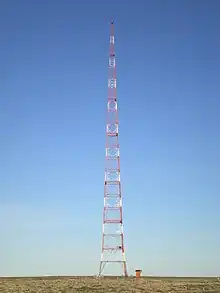Cambridge Bay LORAN Tower was a 189 m (620 ft) tall free-standing lattice tower at Cambridge Bay, Nunavut, Canada. It was built in 1947/48 for LORAN transmissions and was the tallest freestanding structure in Canada for several years. Later the tower was used as a non-directional beacon (NDB) and was often called the "CB" beacon after the morse code letters that it transmitted on 245 kHz, with an output power of 2000 watts.[1] What appeared to be guy-wires on the tower were "top loading" forming part of the antenna. The tower was four sided and the base 18 m (59 ft) per side or 324 m2 (3,490 sq ft).
The tower, built in 1947, became redundant with the construction of the Distant Early Warning Line in the 1950s.[2][3]
In 2013, the tower was determined to be structurally unsound and scheduled for demolition, to be replaced by a 160 ft (49 m) tower. The removal, which was supposed to have been completed in October 2013, didn't begin until the evening of 4 August 2014 and was completed on 5 August 2014.[4][5][6]
See also
References
- ↑ Canada Flight Supplement. Effective 0901Z 16 July 2020 to 0901Z 10 September 2020.
- ↑ "Cold War casualty". Archived from the original on March 4, 2016.
- ↑ Cambridge Bay at the Canadian Encyclopedia
- ↑ "Last call for tallest tower in western Nunavut". CBC News North. November 12, 2013. Retrieved April 25, 2020.
- ↑ "Cambridge Bay, Nunavut Replacement of the 'CB' NDB" (PDF). NAV Canada. Archived from the original (PDF) on March 4, 2016. Retrieved April 25, 2020.
- ↑ "Cambridge Bay residents bid farewell to a trusty old friend". Nunatsiaq News. August 8, 2014. Retrieved April 25, 2020.
External links
69°06′53″N 105°00′56″W / 69.11472°N 105.01556°W
